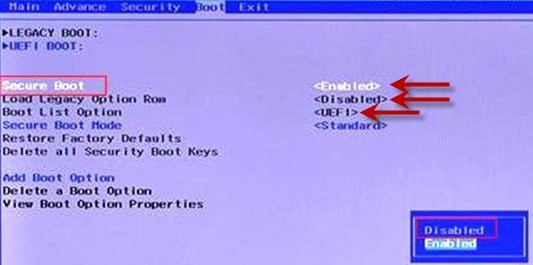
- #Dell xps 8700 disable secure boot windows 10 how to#
- #Dell xps 8700 disable secure boot windows 10 install#
- #Dell xps 8700 disable secure boot windows 10 drivers#
- #Dell xps 8700 disable secure boot windows 10 manual#
- #Dell xps 8700 disable secure boot windows 10 upgrade#
Select * From Win32_ComputerSystem WHERE Manufacturer LIKE "%DELL%" Next, add a Group called Dell BIOS-UEFI Configuration and put a WMI condition on the group with the following query:

the condition will always evaluate to false and allow the step to be skipped (cause we really do not want to apply an OS image yet). it will make CM set this as an OSD TS so that we can boot into WinPE and run it, 2. This is very important for two reasons – 1. Otherwise, add an Apply Operating System Image step called Dummy Step to trick CM and put a Task Sequence variable condition on the step so that the TS variable NEVERTRUE equals TRUE.
#Dell xps 8700 disable secure boot windows 10 install#
For those of you using Nomad, create the Set Nomad as Download Program (new in Nomad 6.0) and Install and Configure Nomad in Windows PE as the first two steps. We will cover handling bare disks at another time. NOTE: This Task Sequence example will only work on systems that already have a formatted disk. For this example, I am going to give it the name of BIOS-UEFI Configuration for Windows 10. The first thing we need to do is create a custom Task Sequence.
#Dell xps 8700 disable secure boot windows 10 manual#
This will not only increase standardization in your environment, but also prevent costly mistakes made by manual processes. Now, I am going to show you an example on how it can be used in WinPE via PXE boot (of course, I use 1E PXE Everywhere 3.0 which is part of Nomad 6.0) to enforce these standards.
#Dell xps 8700 disable secure boot windows 10 how to#
In my previous post, How to create a Dell Command-Configure Package in ConfigMgr, I showed how you could set up the Dell Command-Configure Package in order to use it in OSD Task Sequences. For the ones that don’t (including brand new systems), then you definitely want to start configuring them for UEFI and Secure Boot now!
#Dell xps 8700 disable secure boot windows 10 upgrade#
The quickest approach to getting to Windows 10 is the In-place upgrade path and it might make sense to do this on the systems that qualify. This is one of the limitations of using the Windows 10 In-place upgrade method, as it does not support changing the disk partitioning structure. This means that your Windows 7 systems have MBR partitioned disks and in order to make the switch to UEFI, these systems need to be re-partitioned. If you were one of the many companies that either skipped Windows 8/8.1 or only deployed it in limited quantities, then chances are you deployed your systems for legacy BIOS mode. The first version of Windows that support Secure Boot was Windows 8 and Windows Server 2012.
#Dell xps 8700 disable secure boot windows 10 drivers#
Secure Boot prevents loading of drivers and OS loaders that are not signed with a certified digital signature, thus preventing malware and root kits that alter the boot process. A system needs to be configured for UEFI (without Compatibility Support Module being enabled) in order to take advantage of Secure Boot (and other Windows 10 security features like Device Guard). Yeah, i noticed i cant delete any of the partitions that are usually made when i installed Win10, so ill do that.If you are starting to deploy Windows 10 (or are currently deploying Windows 8/8.1), then now is the time to make the switch to UEFI. Ive used it in the past (created roughly 6 months ago) with no issues seen till now. USB 2.0 8GB Kingston USB loaded with a bootable Windows 10 Pro X64 ISO that i flashed from my office computer. It just baffled me as to why Dell set it this way by default.Ģ. Exactly! I'm not, nor am i planning on ever, using a RAID configuration with this particular desktop.



 0 kommentar(er)
0 kommentar(er)
